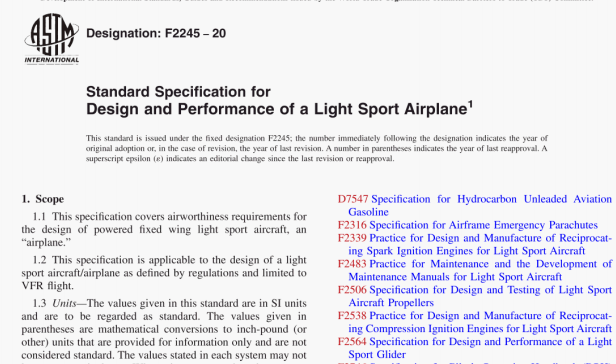ASTM F2245:20 pdf download.Standard Specification for Design and Performance of a Light Sport Airplane.
4.5.5.5 The airplane shall demonstrate compliance with this section while in trimmed steady flight for each flap and power setting appropriate to the following configurations: (1) climb (flaps as appropriate and maximum continuous power): (2) cruise (flaps retracted and 75 % maximum continuous power); and (3) approach to landing (flaps fully extended and engine at
4.5.6 Dynamic Stability—Any oscillations shall exhibit decreasing amplitude within the appropriate speed range (1 .1 V, to maximum allowable speed specified in the POH, both as appropriate to the configuration).
4.5.7 Wings Level Stall—It shall be possible to prevent more than 200 of roll or yaw by normal use of the controls during the stall and the recovery at all weight and CG combinations.
4.5.8 Turning Flight and Accelerawd Turning Stalls:
4.5.8.1 With the airplane initially trimmed for 1.5 V, turning flight and accelerated turning stalls shall be performed in both directions as follows: While maintaining a 30° coordinated turn, apply sufficient pitch control to maintain the required rate of speed reduction until the stall is achieved. After the stall, level flight shall he regained without exceeding 60° of additional roll in either direction. No excessive loss of altitude nor tendency to spin shall he associated with the recovery. The rate of speed reduction must be nearly constant and shall not exceed 0.5 mIs2 (mis per second) (1 kt/s) for turning flight stalls and shall be 1 .5 to 2.5 m/s2 (mis per second) (3 to 5 kt/s) for accelerated turning stalls. The rate of speed reduction in both cases is controlled by the pitch control.
4.5.8.2 Both turning flight and accelerated turning stalls shall be performed: (1) with flaps retracted, at 75 % maximum continuous power and at idle; and (2) with flaps extended, at 75 % maximum continuous power and at idle (speed not to exceed VFE).
(1) Flaps extended conditions include fully extended and each intermediate normal operating position.
(2) If 75 % of maximum continuous power results in pitch attitudes greater than 30° for non-acrobatic aircraft, the power setting may be reduced as necessary as follows, but in no case be less than 50 % of maximum continuous power.
(a) For flaps retracted, the power setting may be reduced as necessary to not exceed 30° pitch attitude.
(b) For any flap extended condition, the test may he carried out with the power required for level flight in the respective configuration at maximum landing weight and a speed of 1.4 Vsl.
Note 2—If the power setting was reduced to prevent exceeding 300 pitch attitude, then the FOH or Flight Training Supplement must note that the aircraft is not approved tir pitch attitudes greater than 30°.
4.5.9 Spinning:
4.5.9.1 For airplanes placarded “no intentional spins,” the airplane must be able to recover from a one-turn spin or a 3-s spin, whichever takes longer, in not more than one additional turn, with the controls used in the manner normally used for recovery.
4.5.9.2 For airplanes in which intentional spinning is allowed, the airplane must be able to recover from a three-turn spin in not more than one and one-half additional turn.
ASTM F2245:20 pdf download
